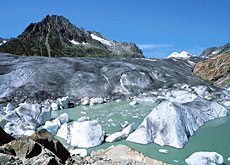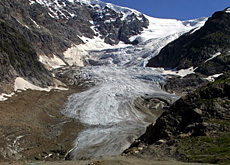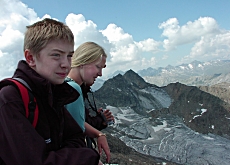Experts size up glaciers as they melt away

The latest conclusions by glaciologists do not make happy reading – Switzerland's ice sheets are melting at a faster rate than ever.
Research is underway to determine the effects of this and to prepare for the worst.
The most recent glacial period ended about 10,000 years ago. With Europe covered by ice, only the highest alpine summits were exposed, and the climate was not only cold, but dry as well.
In more recent times, the cooling period known as the Little Ice Age came to an end in the mid 19th century. And alpine glaciers have been on the retreat ever since.
The changes are closely followed by Swiss glaciologists and geographers, who started measuring the country’s largest 121 glaciers in 1881.
The measurements are still based on basic elements of mathematics, geometry and trigonometry, just as they were 100 years ago. Only the instruments have changed.
According to meteorologist and glaciologist Giovanni Kappenberger, it is not only important to measure the length of an ice sheet but record its mass balance – the difference between the winter accumulation and summer melting – as well as the surface movement and the total volume.
“The mass balance better reflects the climate conditions of the previous year and therefore allows you to follow the current changes,” Kappenberger tells swissinfo.
Fragmented ice
Today the total Swiss ice mass is fragmented into 1,800 glaciers of various dimensions, ranging from the 23km-long Aletsch to glaciers of just a few metres in diameter.
Kappenberger says ice sheets are most influenced by spring rainfall and the type of summer.
“If it snows enough before the hot season, the ice benefits from a natural layer of protection and the melting is contained. A long summer heatwave, with no precipitation, can on the other hand be fatal and result in up to 10cm of ice being lost a day,” he said.
The mild winter temperatures of 2006 and this year have not had a significant impact on the glaciers, but have influenced snowfall, says Kappenberger.
“Usually when we go up onto the Basodino glacier in [Italian-speaking] Ticino in mid-May, we have to use seal skins [on our skis]. This year we walked up on a thick layer of grass,” he said.
According to a study carried out by the Federal Institute of Technology in Zurich, the period between the autumns of 2005 and 2006 was particularly difficult.
It is estimated that Swiss glaciers lost between three and four per cent of their volume and between two and 2.5 metres of thickness during this time.
“In general, it can be said that melting has clearly accelerated since 1998,” said the glaciologist.
Gloomy future
There are large changes ahead for the Alps as scientists are predicting temperatures will rise by between two and 4.5 degrees Celsius by 2100. Under this scenario, only the high altitude glaciers above 4,000m would survive.
“Considering current developments, not even covering the glaciers with special [reflective] materials as was done in Andermatt in 2005, can stop them melting,” said Martin Funk, a glaciologist at the Federal Institute of Technology.
Possible effects of thawing could be a slow colonisation of former glaciated zones by vegetation and the appearance of new alpine lakes.
“Without the ice, water cannot be stored in solid form and therefore there won’t be any reserves in case of drought,” notes Andreas Bauder from the Swiss Glacier Monitoring Network.
Researchers are also trying to forecast the effects of this potential lack of water on agriculture, biodiversity and tourism and the consequences of glacier erosion on the stability of mountain slopes.
Under consideration as well is the impact on large rivers and power generation, as nearly 60 per cent of electricity produced in the country stems from hydroelectric plants and dams.
swissinfo, based on an Italian article by Luigi Jorio
In Switzerland there are around 1,800 glaciers. The 23km-long Aletsch is the largest in Europe. It is also part of a Unesco World Heritage Site.
Between 1850 and 2005, the total glacier surface area shrank by 40% and the volume reduced by 60%, according to the Swiss Academy of Sciences. Currently the glaciers are retreating at an average rate of 3% a year.
It is estimated that the 2003 heatwave caused 1.8% of Alpine glaciers to melt.
Experts say that a rise in temperature of 3 degrees by 2100 could reduce glaciers by 80% compared with today. If temperatures rose by 5 degrees, the glaciers would totally disappear.

In compliance with the JTI standards
More: SWI swissinfo.ch certified by the Journalism Trust Initiative




You can find an overview of ongoing debates with our journalists here. Please join us!
If you want to start a conversation about a topic raised in this article or want to report factual errors, email us at english@swissinfo.ch.